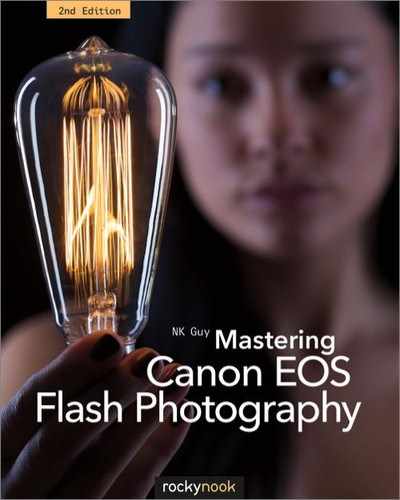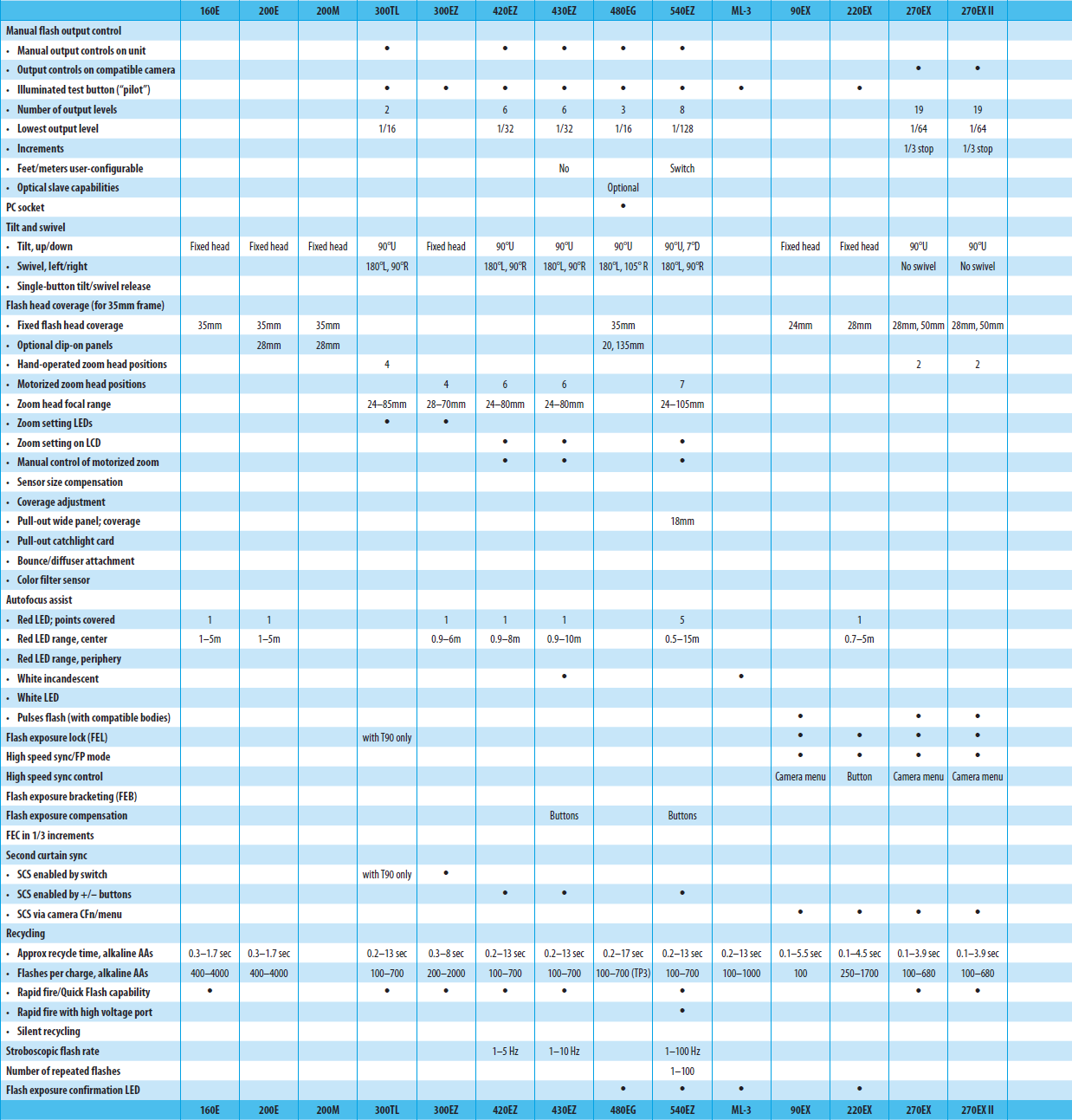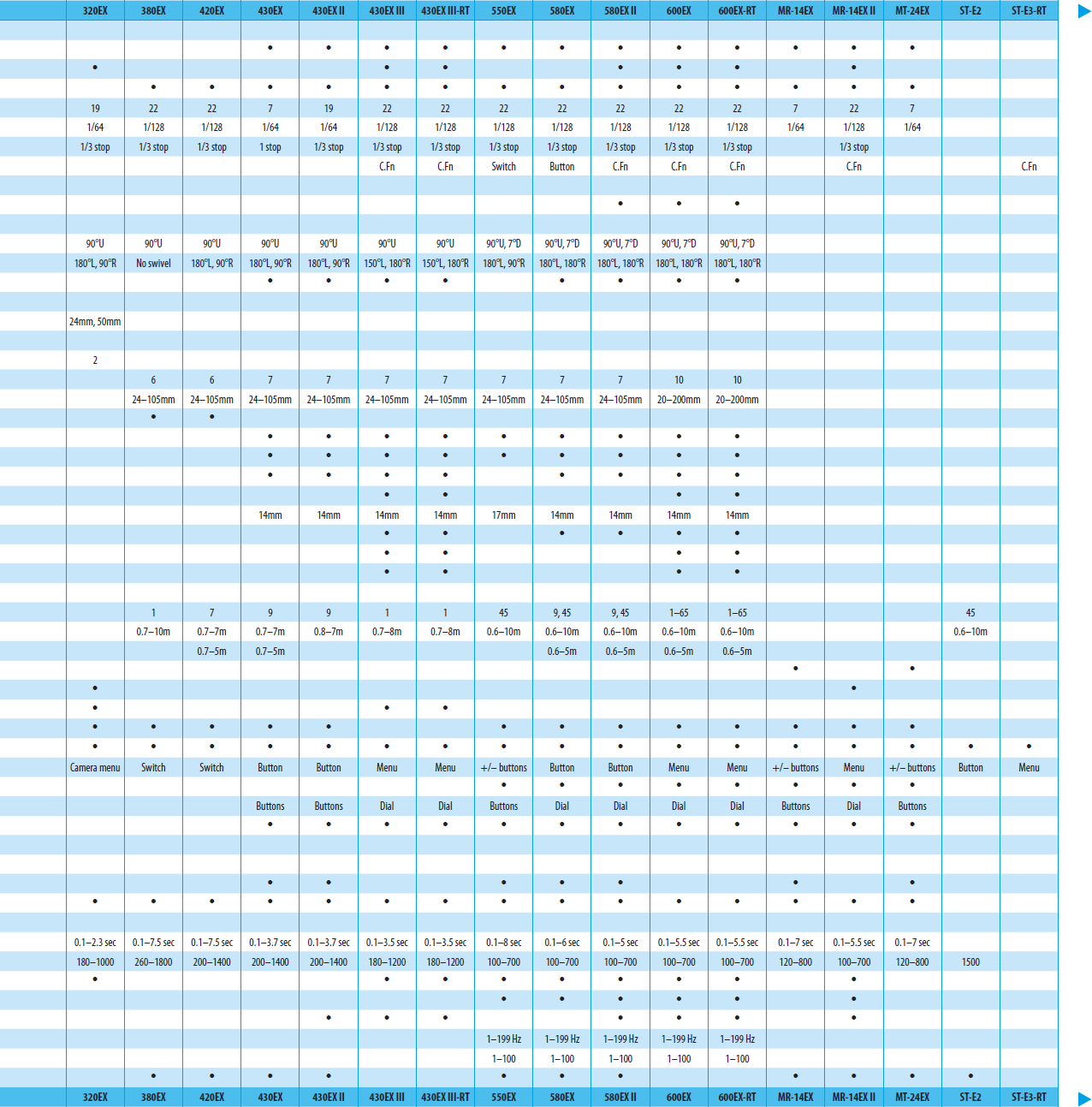Appendix C: Features Table

For an enlarged PDF view of these tables, please visit the publisher’s website at rockynook.com
Choose “Mastering Canon EOS Flash Photography” and then select “Look Inside/Add Ons.”
Key to Appendix C: Features Tables
Medium. Recording medium: 35mm film, APS film, digital SLR.
Model name. If multiple model names are listed, it’s because the same camera is sold under different names in different regions. For example, the camera known as the 500D in Europe and most of Asia is sold under the name Digital Rebel T1i in Canada and the U.S., and under the name Kiss X3 Digital in Japan. There are rarely any major differences between variants.
Year introduced. The year in which the camera was released.
Maximum X-sync. The highest shutter speed at which normal (non high-speed sync) flash photography is possible. See 7.11.
TTL metering. Whether TTL (through the lens) flash metering is supported. TTL flash metering is a film-only feature, and is never supported on digital bodies. Some digital cameras will fire TTL or A-TTL flash units at full power, whereas other digital bodies will not fire them at all. See 7.2.
TTL zones. The number of metering zones used by TTL or A-TTL. See 7.9.3.
A-TTL metering. Advanced TTL, a film-only variant of TTL metering. See 7.3.
E-TTL metering. Evaluative TTL, a flash metering system used by later film and all digital EOS bodies. See 7.4.
E-TTL II metering. An improved version of E-TTL. See 7.5.
Evaluative zones. The number of metering zones employed by the camera’s evaluative metering system. See 7.8.5.
Red AF assist. The camera has a built-in red LED to help autofocus perform in low light conditions. See 9.7.1.
White AF assist. The camera has a bright white lamp to help autofocus perform in low light conditions. See 9.7.4.
Pulse AF assist. The camera pulses its popup flash unit in order to help autofocus perform in low light conditions. See 9.7.5.
Speedlite AF assist. The camera is able to use a directly connected Speedlite’s autofocus assist light. See 9.7.
Disable Internal. The camera can disable its internal AF assist. See 9.7.6.
Disable Speedlite. The camera can disable an external Speedlite’s AF assist.
Disable assist. The camera can disable autofocus assist altogether.
Speedlite red/pulse. The camera can distinguish between Speedlites with red AF assist lights and those that pulse the main tube for AF assist.
Built-in flash. The camera has a built-in popup flash unit. See 8.1.
Built-in flash GN. The metric guide number of the internal flash. See 7.15.
Flash coverage. The coverage of the internal flash unit, equivalent to the focal length of a lens. In the case of cropped image sensors, the actual focal length supported is used. See 9.5.
Flash zooms. The internal flash unit has a motorized zooming head.
Flash auto raises. The internal flash unit can pop up automatically, if light levels are low and if the camera is in an icon mode which uses flash.
Flash auto lowers. The internal flash unit has a motorized system for lowering the flash unit (no need to push it down manually).
Tall flash. The internal flash unit is on a longer strut system to raise the flash head farther from the center of the lens, thus reducing redeye slightly.
Popup flash manual. The internal flash unit can have its output settings specified manually. See 9.16.
Popup flash stroboscopic. The internal flash unit can pulse stroboscopically. See 9.21 and 15.8.
Redeye reduction. The camera has some form of redeye reduction system, typically a brief, bright light to cause a person’s pupils to contract. See 9.8.
Optical wireless. The camera can support Canon’s optical wireless E-TTL flash metering system, which uses pulses of visible light or infrared energy to send signals. See 9.17 and 11.8.
Radio compatible. The camera predates the release of radio wireless. It’s a digital camera which can use radio wireless E-TTL only in basic three-group mode. See 11.11.3.
Radio aware. A digital camera which was designed from the start to support radio, and thus supports all advanced radio features. See 11.11.3.
Wireless ratios. Support for A, B, and C wireless ratios. See 11.8.4.
Popup flash master. The camera’s built-in flash unit can control remote wireless E-TTL slave units. No additional hardware is required. See 9.18.
Internal FEC. The camera has on-board controls for flash exposure compensation. See 9.9.
External FEC. The camera supports flash exposure compensation on an external Speedlite if FEC controls are built into the flash unit.
FEC in viewfinder. The camera displays FEC settings in the viewfinder.
Flash micro adjustment. The camera can bias normal flash exposure settings. See 9.9.1.
FEL controls. The camera has a means for flash exposure lock (e.g., a separate FEL button, or the function is tied to AE lock). See 9.10.
FEL icon. The camera displays FEL information in the viewfinder.
Modeling light. Support for simulated modeling lights with external Speedlite flash units. See 9.24.
FEB. Support for flash exposure bracketing. See 9.13.
Zoom adjust. A digital camera can instruct an external Speedlite that a subframe image sensor is in use and compensate accordingly. See 9.5.4.
Auto fill. The camera can disable auto fill flash reduction. See 9.12.
PC socket. The camera has a socket for external sync-only flash. See 11.4.
Ignores PC polarity. The camera doesn’t care about the polarity of a PC connector (i.e., whether the tip is positive or negative).
250v trigger voltage. The camera’s hotshoe, and PC socket if present, can withstand up to 250 volt flash trigger circuits. See 10.5.
Second curtain sync. The camera is capable of supporting second curtain sync with directly connected Speedlite flash units. See 7.13.
SCS internal. The camera has internal controls (a menu item or a custom function) for enabling or disabling second curtain sync.
SCS external. The camera supports or honors any second curtain sync controls on an external Speedlite.
Weatherproofed. The camera has some form of sealing (rubber gaskets and so on) to protect it against dust or inclement weather. See 9.34.
CPU type. The type of internal digital image processor used by the camera.
ESC menu control. The camera can control a compatible Speedlite via a menu system. Various flash unit settings can be adjusted. See 9.30.
Ext.A autoflash. The camera can send ISO and aperture data to a 580EX II flash unit if it’s in autoflash mode. See 9.26.1.
Color temp. The camera can receive data from a compatible flash unit for minor color adjustments. See 9.35.
Auto ISO, bounce. The camera can tell if the Speedlite is in bounce mode and, if so, increases auto ISO settings to compensate. See 9.4.
Live View. The camera can display live video from the sensor chip directly on the camera’s preview screen. See 9.36.
Live View silent mode. The camera can use electronic first curtain in Live View for quieter performance. Silent mode is not compatible with flash.
LV, no ext. flash. The camera cannot fire studio flash units (i.e., non-Speedlite sync-only flash units) when in Live View mode.









